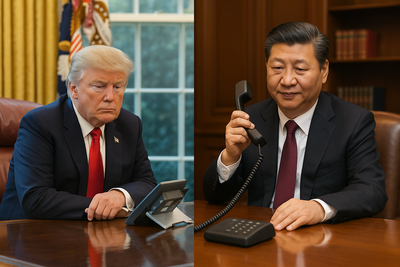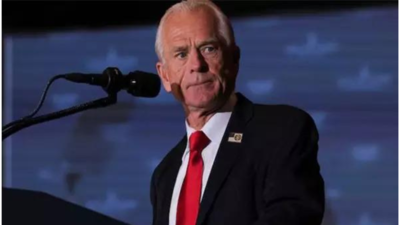Magnets over missiles: How Xi turned US trade war inside out – and made Trump blink

In the end, it wasn’t tanks, tariffs, or technology that brought US President Donald Trump back to the negotiating table with China. It was a set of obscure elements most Americans have never heard of-and which the modern world can’t function without.“FULL MAGNETS, AND ANY NECESSARY RARE EARTHS, WILL BE SUPPLIED, UP FRONT, BY CHINA,” Trump posted on Truth Social, his digital megaphone of choice, declaring a new trade pact with Beijing was “DONE,” pending final approval from both him and President Xi Jinping.For a president who once claimed China had “no leverage,” it was a stunning admission. While Washington had spent years building up chip sanctions, export bans, and visa restrictions, Xi Jinping had something simpler and more powerful: control of the supply chain of rare earths.Rare earths-specifically the nickel-sized magnets made from them-have become China’s ace in an increasingly antagonistic trade rivalry. The magnets power everything from electric vehicle motors to F-35 fighter jets. And when Beijing slowed exports this spring, it didn’t just rattle Washington. It paralyzed factories from Chicago to Mumbai.The big picture: Magnets that move marketsIn April, as Trump pushed tariffs on Chinese imports past 100%, Beijing countered with an export-licensing regime that slowed the global flow of rare-earth magnets to a crawl. Chinese producers, once loosely regulated, now required detailed applications specifying the final use of every shipment-including, in some cases, photographs of the final products.“They are showing their muscles,” one unnamed company told The Wall Street Journal, after struggling to comply with China’s sudden documentation demands.But when China slammed the brakes on rare earth shipments, it created a cascading industrial crisis:
- Ford halted production of its Explorer SUV in Chicago for a week.
- Tesla reported rare earth shortages affecting its Optimus robot actuators.
- Volkswagen quietly asked suppliers to find components with fewer rare earths.
- Defense contractors warned that stockpiles of critical magnets were running dry.
- Even drone supply lines to Ukraine were disrupted.
The magnets themselves weren’t the only problem. They became a proxy for China’s strategic intent-and its willingness to weaponize dominance.“This is not just about minerals,” said Gracelin Baskaran, director of the critical minerals program at CSIS. “China’s dominance puts American companies at direct risk given that any sort of agreements that have been made can be reneged on.”A trade deal-on China’s termsBy June, Beijing’s strategy had succeeded in creating global unease and American urgency. When negotiators met in London last week to hammer out a fresh pact, the conversation tilted toward raw materials, not rhetoric.In Trump’s telling, the US walked away with a win: “WE ARE GETTING A TOTAL OF 55% TARIFFS, CHINA IS GETTING 10%.” But beneath the bluster, the facts point to a Chinese strategic victory.The deal, as relayed by US commerce secretary Howard Lutnick, involved China front-loading rare-earth shipments critical to “US auto and defense firms,” while Washington would “ease some of its own export controls.” In short, China got what it wanted-greater access to US markets for students and products-without giving up control of its minerals.Xi, who did not publicly comment, appears to have made clear that any further exports are conditional, governed by a new licensing system that gives Chinese regulators granular visibility into global supply chains.Shan Guo, a partner at Hutong Research in Shanghai, put it bluntly: “Both sides would want deterrence… There is little political trust in each other.”Not rare, but invaluable
- Rare earths aren’t especially rare. What makes them powerful-and dangerous as a diplomatic tool-is how concentrated their processing has become. By the late 1990s, China had underpriced most of the West’s rare-earth industry out of existence. Today, it produces more than 90% of the world’s rare-earth magnets.
- Attempts to diversify are underway. MP Materials, based in the US, is opening a plant in Texas with plans to produce magnets for General Motors. Australia’s Lynas Rare Earths is expanding processing capacity in Malaysia. But these efforts remain in early stages.
- “The pain the industry is going to go through… is what is going to incentivize people to actually start putting the investment” into alternatives, said Rowena Smith, CEO of Australian Strategic Materials.
- What is noteworthy is that China has leverage not only over America but over much of the industrialized world.
A history of leverageThis wasn’t China’s first use of rare earths as a geopolitical tool. In 2010, amid a maritime dispute, Beijing quietly halted shipments to Japan. The result? Japan began a decade-long process of building its own supply chain.The lesson for Washington might be similar. Yet in the near term, the US remains dependent. And Trump-despite his posturing-was forced to concede. The White House, which had vowed that “China needs to make a deal with us, we don’t have to make a deal with them,” found itself asking for precisely that.The Wall Street Journal’s Christopher Wood called it “damage control” disguised as diplomacy. “What’s become clear… is that this rare-earths issue has got real leverage for Beijing,” he said.The element Xi won’t let go
- Trump may have declared victory, but the structure of the deal is Xi’s. Rare-earth exports will resume-for now. Tariffs are down-for now. But China’s permitting regime remains in place, and officials in Beijing have made it clear they’ll be watching where every shipment goes, and why.
- It’s not just about materials anymore. It’s about knowledge, influence, and control. And in this trade war, China has shown that it’s willing to pull the one lever the US can’t yet match.
- “China played the card of the rare earths very well,” said Steve Brice, chief investment officer at Standard Chartered.
- Even in a global economy shaped by algorithms and silicon, it turns out the most powerful weapon might still be something pulled from the ground.
(With inputs from agencies)




